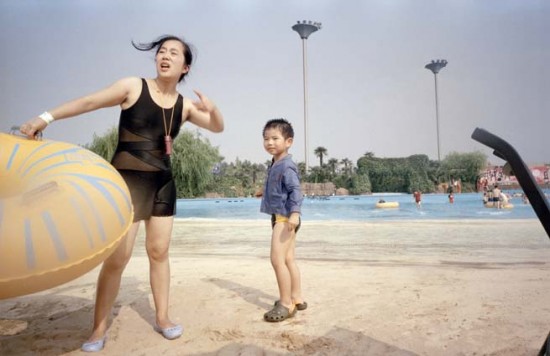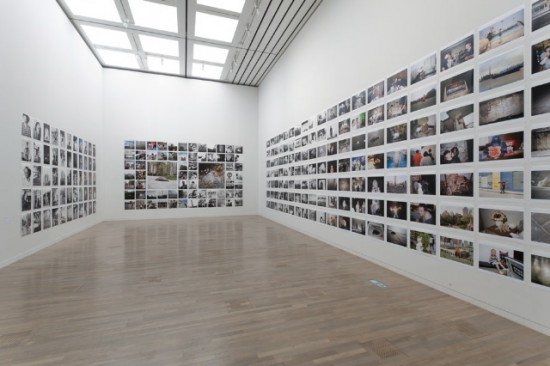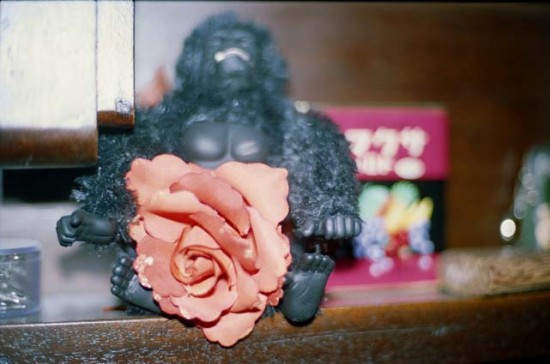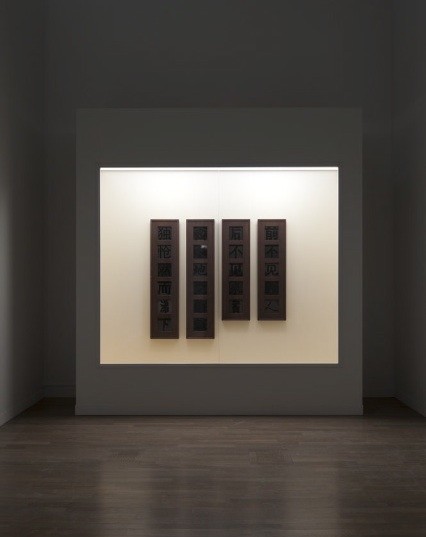
From Welcome to Birdhead World Again in Tokyo 2011 – What we take before, now, and in the future is all the same. All images: Courtesy the artists.
Established by the artists Ji Weiyu and Song Tao in 2004, Birdhead is a collaborative unit that uses photography to explore the social and built landscape of contemporary Shanghai and the artists’ physical relations to that environment. The unit’s works have been selected for inclusion in the artistic director’s exhibition at the 54th Venice Biennale, “ILLUMInations,” curated by Bice Curiger. ART iT corresponded with Ji Weiyu and Song Tao to learn more about their plans for Venice and their distinctive approach to photography.
Interview:
ART iT: You will be included in this year’s Venice Biennale, which takes the theme “ILLUMInations.” How do you think your work relates to the exhibition concept?
Birdhead: Bice Curiger has stated about her exhibition, “I have found in the works of numerous contemporary artists (those that most interest me) a shared exploration of light that, whether rational or feverish, strongly evokes the same exploration of light that made Tintoretto’s late-period paintings so vivid. Tintoretto similarly dedicated himself to subverting the conventions of his era, producing works through an almost reckless methodology in order to overturn the well-defined classical order of Renaissance art. What interests me about the light that appears in these paintings is not rationality but, rather, beauty.” In our view the recklesness that Curiger refers to in this passage, as well as her interest not in rationality but in beauty, coincides exactly with the concerns of our long-term project.
ART iT: Your installation Tang Poetry – On a Gate Tower at Yuzhou (2011), recently on view in the “Artist File 2011” exhibition at National Art Center Tokyo, uses photographs of urban signage to recreate a Tang dynasty poem by Chen Zi’ang, and your project for this year’s Venice Biennale includes a similar work that will recreate a poem by Song dynasty poet Xin Qiji, “Chou nu er – Writing on the Wall along the Path to Bo Mountain.” Can you explain more about your interest in poetry and how you came to incorporate it in your photographic projects?
Birdhead: Ah! You ought to know about the manga series Dragon Ball – seven dragon balls have been scattered across the world, and it is said that whoever can gather all seven together can summon a dragon that will grant one wish. We search for those Chinese characters that are either still repeatedly in use or are almost obsolete in contemporary life, and then we collage them into classical poems that we like. It is really the same mindset as Dragon Ball. We have realized this wish.
ART iT: Why is it important for you to make the poetry works through photographs? Does this emphasize the idea that words are also objects with their own histories?
Birdhead: It is not our intent to only emphasize the words’ material histories. In completing the classical poems through photographing the Chinese characters that circulate in contemporary Chinese society, what is important are the links that are produced through the juxtaposition of the significance of the poetry and the significance of the photographs that we constantly take of people in our physical environments, and the atmospheres that they each establish.


Top: Installation view of Welcome to Birdhead World Again in Tokyo 2011 – What we take before, now, and in the future is all the same at the National Art Center, Tokyo, 2011. Bottom: From Welcome to Birdhead World Again in Tokyo 2011 – What we take before, now, and in the future is all the same.
ART iT: How would you describe your approach to photography? For example, you have said, “What we take before, now, and in the future is all the same,” so what does that mean for each individual photograph, or even a specific project like Xin Cun (2006)?
Birdhead: We use formats ranging from 135 film to 4×5 negatives, shooting as we wander about the city, and we also set up specific locations if we feel it’s necessary. The large volume of photographs that we have made since 2004 all originate from various aspects of our lives, so for us an individual photograph can never be more than only a small fragment that has been cut out from that. Maintaining this kind of habitual practice, we think photography takes on significance in continually doing the same thing. To put it exactly, through the medium of photography and the recurring connections with our physical environments that it enables, we attain a kind of spiritual discipline. A project like Xin Cun can also be considered part of this.
ART iT: The way we make and look at photographs has been changed by digital technology, which allows for more volume and less selectivity when shooting, and a wider accessibility to images for viewers. Do you think about this aspect of contemporary photography at all in relation to Birdhead? Has it affected your approach?
Birdhead: We have no concern at all for this aspect of contemporary photography. From the moment we first came into contact with the medium of photography to the present, we have always used film. We were not led to take large volumes of photographs because of developments in digital technology. We shoot so many photographs because it is a necessity for us. We certainly have that many photographs that we can shoot, he, he!

Installation view of Tang Poetry – On a Gate Tower at Yuzhou (2011) at National Art
Center, Tokyo, 2011.
ART iT: Finally, was there any reason for choosing Xin Ciji’s poem for Venice? How about the selection of photos that will also be there?
Our overall plan for Venice has two parts, Song Poetry – Writing on the Wall along the Path to Bo Mountain, and a separate installation of over 200 photographs. The photographs will be selected from those that we have taken from 2004 to the present. They will be arranged on the wall in an orderly grid. The associations between each photograph will manifest different moods, from joy to sorrow to tranquility to anger, and the significance of the poem and the atmospheres contained in all the photos on display will form a complete presentation.
The 54th Venice Biennale, “ILLUMInations,” opens to the public June 4 and continues through November 27.
Return to story index
Venice Biennale – ILLUMInations: 54th International Art Exhibition
